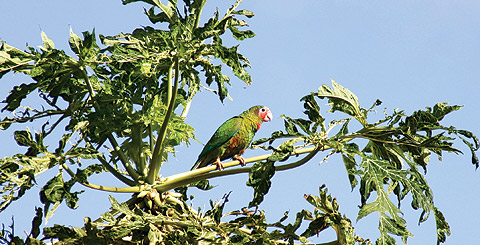 A parrot eyes Mr. Smith’s farm. The Cayman parrots are an endangered species protected by the Department of Environment. – Photos: Jewe LevyCayman parrots are once again taunting farmers and agriculture officers while devouring first fruit crops.
A parrot eyes Mr. Smith’s farm. The Cayman parrots are an endangered species protected by the Department of Environment. – Photos: Jewe LevyCayman parrots are once again taunting farmers and agriculture officers while devouring first fruit crops.
And no amount of hooting, hollering or hazing has changed the situation.
“The parrots have multiplied by the hundreds causing even more damage than last year,” said Farmer Franklin Smith.
Mr. Smith said he has contacted the Department of Agriculture several times about the well-known national symbol, which is a down-right nuisance to young crops because the animals cut away hundreds of young mangos to get at just a tiny soft kernel in the centre.
“Last year the Agriculture Department said they would be carrying out a monitoring process, which involved collecting and sorting the young fruits, which the parrots had cut from the ones which had naturally dropped from the tree but since that time I have had no report.”
In 2012 a repellent trial was conducted on Mr. Smith’s land using a piece of equipment called a Hoot Hazer, explained Brian Crichlow, assistant director at the Agriculture Department.
The methyl anthranilate mist delivered from the Hoot Hazer was effective in reducing the damage caused by the parrots on mango fruits within the treated area of Mr. Smith’s Farm in East End.
A Hoot Hazer is an automated, self-contained high capacity electric ULV fogger and bird hazer that uses methyl anthranilate to disperse flying birds in large open areas. It is designed for rooftops and large open spaces.
The repellent properties of the chemical, methyl anthranilate, were able to reduce parrot damage to mango fruits when applied in the field during the fruiting season, states an Agriculture Department press release. Greater coverage would be obtained if the trees were shorter. However, the trial noted that the area of coverage of a single Hoot Hazer in a field of tall trees is low. Therefore its effectiveness would be more noticeable in areas where trees are pruned regularly to allow better movement and coverage of the mist throughout the canopies, concludes the report.
“This year we are considering trying it on a different farm where conditions maybe more favourable, Mr. Crichlow said. “The Department’s own orchard would be ideal as they have had, and do from time to time, experienced some damage by parrots but by following recommended agronomic practices and pruning the trees to a manageable height, the impact is minimised as the parrots favour taller trees.”
But Mr. Smith isn’t buying it.
“My response to Mr. Crichlow’s findings is this: utter rubbish,” said Mr. Smith who offered some suggestion to keeping the parrots away.
“The parrots could be culled. Take out some of the parrots each year; turn the Botanic Park into an aviary for visitors and locals to visit or let farmers catch the parrot and sell them to families as pets to help compensate farmer’s losses,” he said.
Farmer Harvey Stephenson agreed with Mr. Smith.
“The parrots are getting fat off farmers’ expense. It’s no laughing matter. We can’t shoot them because it is against the law, but we need to find a solution.
Agriculture Director Adrian Estwick also agreed that it was frustrating for farmers to watch their crops being destroyed but there was no easy solution to the dilemma.